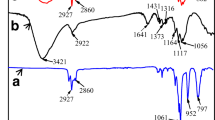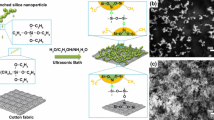Abstract
The removal of oil and organic pollutants from water is highly desired due to increasing industrial oil-contaminated wastewater, as well as frequent oil spill accidents. In this paper, superhydrophobic and superoleophilic fabrics were facilely fabricated for oil/water separation application via in situ growth of polysiloxane nanowires on cotton fabrics. The polysiloxane nanowires were immobilized on the cotton fabrics through a self-assembly process of alkylsilane on the microfibers of fabrics. The combination of the hierarchical structure and the low-surface-energy polysiloxane nanowires greatly contributed to the superhydrophobicity of the fabrics. Furthermore, the superhydrophobicity remained even after they were exposed to different chemicals for 72 h and strong ultraviolet irradiation and repeated abrasion, indicating excellent stability. More importantly, the as-prepared cotton fabrics were successfully used for separating various oil/water mixtures by a solely gravity-driven process with high separation efficiency and desirable durability. The cotton fabrics are commercially available, low-cost, and environmentally friendly materials, and thus such superhydrophobic and superoleophilic cotton fabrics could be very attractive for oil/water separation and oil spill cleanup when high flexibility, strength, and chemical resistance are taken into account.













Similar content being viewed by others
References
Li, X, Wang, M, Wang, C, Cheng, C, Wang, X, “Facile Immobilization of Ag Nanocluster on Nanofibrous Membrane for Oil/Water Separation.” ACS Appl. Mater. Interfaces, 6 (17) 15272–15282 (2014)
Zhang, J, Seeger, S, “Polyester Materials with Superwetting Silicone Nanofilaments for Oil/Water Separation and Selective Oil Absorption.” Adv. Funct. Mater., 21 (24) 4699–4704 (2015)
Asthana, A, Maitra, T, Büchel, R, Tiwari, MK, Poulikakos, D, “Multifunctional Superhydrophobic Polymer/Carbon Nanocomposites: Graphene, Carbon Nanotubes, or Carbon Black?” ACS Appl. Mater. Interfaces, 6 (11) 8859–8867 (2014)
Xue, CH, Guo, XJ, Ma, JZ, Jia, ST, “Fabrication of Robust and Antifouling Superhydrophobic Surfaces via Surface-Initiated Atom Transfer Radical Polymerization.” ACS Appl. Mater. Interfaces, 7 (15) 8251–8259 (2015)
Zhou, X, Zhang, Z, Xu, X, Men, X, Zhu, X, “Facile Fabrication of Superhydrophobic Sponge with Selective Absorption and Collection of Oil from Water.” Ind. Eng. Chem. Res., 52 (27) 9411–9416 (2013)
Liu, X, Ge, L, Li, W, Wang, X, Li, F, “Layered Double Hydroxide Functionalized Textile for Effective Oil/Water Separation and Selective Oil Adsorption.” ACS Appl. Mater. Interfaces, 7 (1) 791–800 (2014)
Song, J, Huang, S, Lu, Y, Bu, X, Mates, JE, Ghosh, A, Ganguly, R, Carmalt, CJ, Parkin, IP, Xu, W, “Self-Driven One-Step Oil Removal from Oil Spill on Water via Selective-Wettability Steel Mesh.” ACS Appl. Mater. Interfaces, 6 (22) 19858–19865 (2014)
Brown, PS, Bhushan, B, “Mechanically Durable, Superoleophobic Coatings Prepared by Layer-by-Layer Technique for Anti-smudge and Oil–Water Separation.” Sci. Rep., 5 8701–8709 (2014)
Liu, YQ, Zhang, YL, Fu, XY, Sun, HB, “Bioinspired Underwater Superoleophobic Membrane Based on a Graphene Oxide Coated Wire Mesh for Efficient Oil/Water Separation.” ACS Appl. Mater. Interfaces, 7 (37) 20930–20936 (2015)
Zheng, X, Guo, Z, Tian, D, Zhang, X, Li, W, Jiang, L, “Underwater Self-Cleaning Scaly Fabric Membrane for Oily Water Separation.” ACS Appl. Mater. Interfaces, 7 (7) 4336–4343 (2015)
Guo, Z, Liu, W, Su, BL, “Superhydrophobic Surfaces: From Natural to Biomimetic to Functional.” J. Colloid Interface Sci., 353 (353) 335–355 (2011)
Cao, Y, Zhang, X, Tao, L, Li, K, Xue, Z, Feng, L, Wei, Y, “Mussel-Inspired Chemistry and Michael Addition Reaction for Efficient Oil/Water Separation.” ACS Appl. Mater. Interfaces, 5 (10) 4438–4442 (2013)
Yang, S, Ju, J, Qiu, Y, He, Y, Wang, X, Dou, S, Liu, K, Jiang, L, “Peanut Leaf Inspired Multifunctional Surfaces.” Small, 10 (2) 294–299 (2014)
Feng, L, Zhang, Y, Xi, J, Zhu, Y, Wang, N, Xia, F, Jiang, L, “Petal Effect: A Superhydrophobic State with High Adhesive Force.” Langmuir, 24 (8) 4114–4119 (2008)
Liu, M, Wang, S, Wei, Z, Song, Y, Jiang, L, “Bioinspired Design of a Superoleophobic and Low Adhesive Water/Solid Interface.” Adv. Mater., 21 (6) 665–669 (2009)
Liu, X, Zhou, J, Xue, Z, Gao, J, Meng, J, Wang, S, Jiang, L, “Clam’s Shell Inspired High-Energy Inorganic Coatings with Underwater Low Adhesive Superoleophobicity.” Adv. Mater., 24 (25) 3401–3405 (2012)
Wu, G, An, J, Tang, XZ, Xiang, Y, Yang, J, “A Versatile Approach Towards Multifunctional Robust Microcapsules with Tunable, Restorable, and Solvent-Proof Superhydrophobicity for Self-Healing and Self-Cleaning Coatings.” Adv. Funct. Mater., 24 (43) 6751–6761 (2014)
Yong, J, Chen, F, Yang, Q, Zhang, D, Bian, H, Du, G, Si, J, Meng, X, Hou, X, “Controllable Adhesive Superhydrophobic Surfaces Based on PDMS Microwell Arrays.” Langmuir, 29 (10) 3274–3279 (2013)
Su, F, Yao, K, “Facile Fabrication of Superhydrophobic Surface with Excellent Mechanical Abrasion and Corrosion Resistance on Copper Substrate by a Novel Method.” ACS Appl. Mater. Interfaces, 6 (11) 8762–8770 (2014)
Li, B, Wu, L, Li, L, Seeger, S, Zhang, J, Wang, A, “Superwetting Double-Layer Polyester Materials for Effective Removal of Both Insoluble Oils and Soluble Dyes in Water.” ACS Appl. Mater. Interfaces, 6 (14) 11581–11588 (2014)
Li, L, Li, B, Wu, L, Zhao, X, Zhang, J, “Magnetic, Superhydrophobic and Durable Silicone Sponges and Their Applications in Removal of Organic Pollutants from Water.” Chem. Commun., 50 (58) 7831–7833 (2014)
Wang, H, Fang, J, Cheng, T, Ding, J, Qu, L, Dai, L, Wang, X, Lin, T, “One-Step Coating of Fluoro-Containing Silica Nanoparticles for Universal Generation of Surface Superhydrophobicity.” Chem. Commun., 7 (7) 877–879 (2008)
Zou, H, Lin, S, Tu, Y, Liu, G, Hu, J, Li, F, Miao, L, Zhang, G, Luo, H, Liu, F, “Simple Approach Towards Fabrication of Highly Durable and Robust Superhydrophobic Cotton Fabric from Functional Diblock Copolymer.” J. Mater. Chem. A, 1 (37) 11246–11260 (2013)
Liu, X, Liang, Y, Zhou, F, Liu, W, “Extreme Wettability and Tunable Adhesion: Biomimicking Beyond Nature?” Soft Matter., 8 (7) 2070–2086 (2012)
Deng, B, Cai, R, Yu, Y, Jiang, H, Wang, C, Li, J, Li, L, Yu, M, Li, J, Xie, L, “Laundering Durability of Superhydrophobic Cotton Fabric.” Adv. Mater., 22 (48) 5473–5477 (2010)
Xue, CH, Ji, PT, Zhang, P, Li, YR, Jia, ST, “Fabrication of Superhydrophobic and Superoleophilic Textiles for Oil–Water Separation.” Appl. Surf. Sci., 284 (11) 464–471 (2013)
Chen, Q, Leon, AD, Advincula, RC, “Inorganic–Organic Thiol-ene Coated Mesh for Oil/Water Separation.” ACS Appl. Mater. Interfaces, 7 (33) 18566–18573 (2015)
Kong, LH, Chen, XH, Yu, LG, Wu, ZS, Zhang, PY, “Superhydrophobic Cuprous Oxide Nanostructures on Phosphor–Copper Meshes and Their Oil–Water Separation and Oil Spill Cleanup.” ACS Appl. Mater. Interfaces, 7 (4) 2616–2625 (2015)
Li, Z, Xing, Y, Dai, J, “Superhydrophobic Surfaces Prepared from Water Glass and Non-fluorinated Alkylsilane on Cotton Substrates.” Appl. Surf. Sci., 254 (7) 2131–2135 (2008)
Xi, B, Verma, LK, Li, J, Bhatia, CS, Danner, AJ, Yang, H, Zeng, HC, “TiO2 Thin Films Prepared via Adsorptive Self-Assembly for Self-Cleaning Applications.” ACS Appl. Mater. Interfaces, 4 (4) 1093–1102 (2012)
Anandan, S, Rao, TN, Sathish, M, Rangappa, D, Honma, I, Miyauchi, M, “Superhydrophilic Graphene-Loaded TiO2 Thin Film for Self-Cleaning Applications.” ACS Appl. Mater. Interfaces, 5 (1) 207–212 (2013)
Rollings, DE, Veinot, JGC, “Polysiloxane Nanofibers via Surface Initiated Polymerization of Vapor Phase Reagents: A Mechanism of Formation and Variable Wettability of Fiber-Bearing Substrates.” Langmuir, 24 (24) 13653–13662 (2008)
Gao, L, Mccarthy, TJ, “A Perfectly Hydrophobic Surface (θA/θR 180°/180°).” J. Am. Chem. Soc., 128 (28) 9052–9053 (2006)
Hidetsugu, S, Thomas, P, Rudolf, P, Hans, K, “Simultaneous Gold Deposition and Formation of Silicon Nanowire Arrays.” J. Electroanal. Chem., 558 (3) 35–39 (2003)
Stojanovic, A, Olveira, S, Fischer, M, Seeger, S, “Polysiloxane Nanotubes.” Chem. Mater., 25 (14) 2787–2792 (2013)
Helmy, R, Wenslow, RW, Fadeev, AY, “Reaction of Organosilicon Hydrides with Solid Surfaces: An Example of Surface-Catalyzed Self-Assembly.” J. Am. Chem. Soc., 126 (24) 7595–7600 (2004)
Zhang, J, Wang, A, Seeger, S, “Universal Self-Assembly of Organosilanes with Long Alkyl Groups into Silicone Nanofilaments.” Polym. Chem., 5 (4) 1132–1139 (2014)
Acknowledgments
This work was financially supported by the University Scientific Research Innovation Team Program of the Education Department of Sichuan Province [Grant Number 16TD0009], the Scientific Research Innovation Team Program of Southwest Petroleum University [Grant Number 2013XJZT005], the Major Breeding Project of the Education Department of Sichuan Province [Grant Number 13CZ0027], Open Experiment Program of SWPU [Grant Number KSZ16106], and the Open Project Program of High-Tech Organic Fibers Key Laboratory of Sichuan Province.
Author information
Authors and Affiliations
Corresponding authors
Ethics declarations
Conflict of interest
The authors declare that there are no conflicts of interest for this manuscript. All the funding support has been acknowledged in the manuscript.
Electronic supplementary material
Below is the link to the electronic supplementary material.
Rights and permissions
About this article
Cite this article
Wang, B., Lei, B., Tang, Y. et al. Facile fabrication of robust superhydrophobic cotton fabrics modified by polysiloxane nanowires for oil/water separation. J Coat Technol Res 15, 611–621 (2018). https://doi.org/10.1007/s11998-017-0002-y
Published:
Issue Date:
DOI: https://doi.org/10.1007/s11998-017-0002-y




